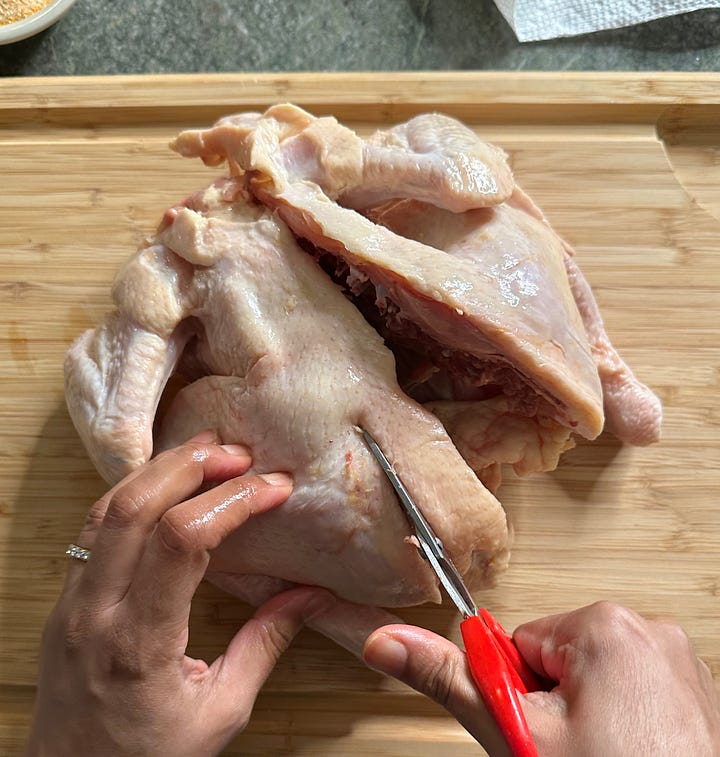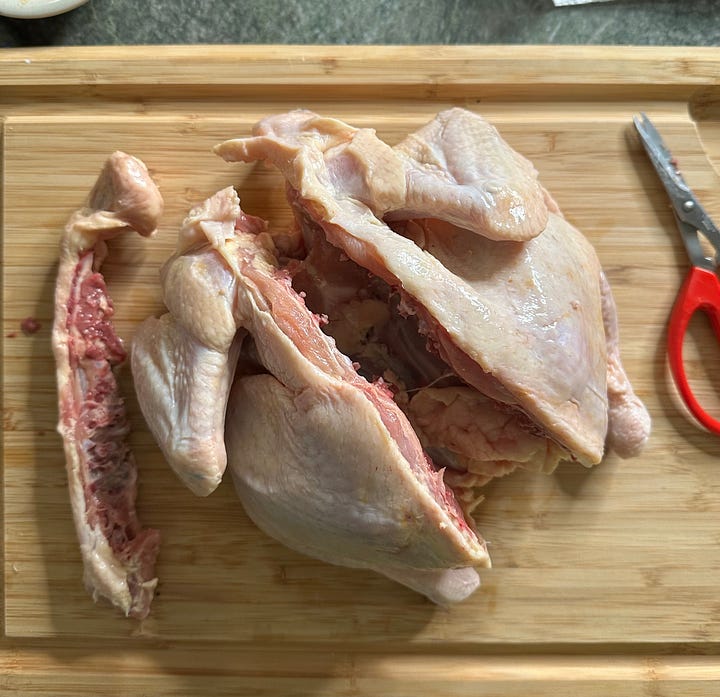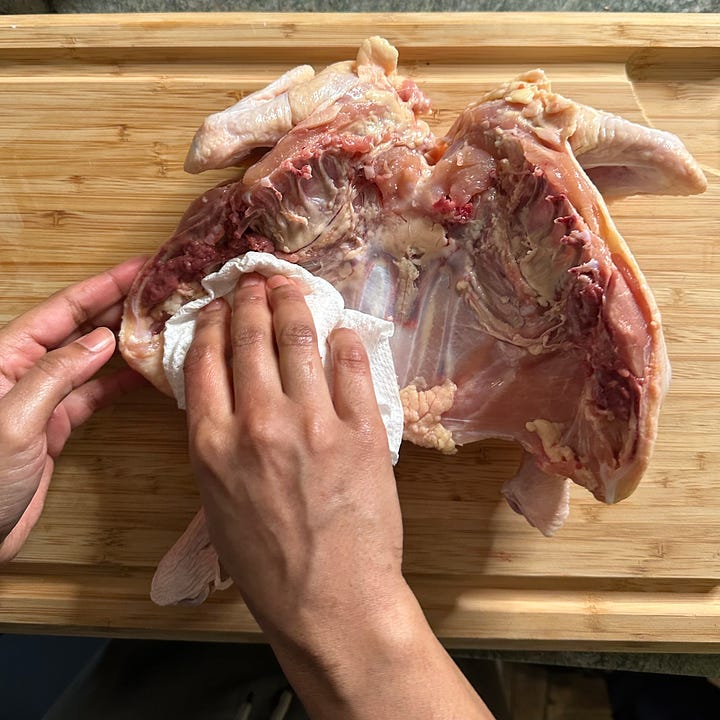

Discover more from Hot Dish with Sohla
(Not Really) Bangladeshi Wedding Chicken
No nuptials needed, just let salt, acid, and time do the hard work for you
Hi All!
(What I actually want to say is Hi Y’all, but I’m not southern so I don’t think I can get away with that. I am currently accepting intro suggestions in the comments below.)
Welcome to the first installment of the bigger and badder Hot Dish. We’re kicking things off with this killer roast chicken recipe. I know, I know. How many roast chicken recipes does anyone need? Just this one. I promise.
Because it’s the time of year when I’m always looking for an excuse to turn the oven on to heat our basement apartment, I’ve been roasting birdies every week. I roasted them under bricks, low-temp, high-temp, wet-brine, dry-brine, buttermilk brine, and hot damn, I think I finally cracked the code for supremely juicy, flavorful, tender meat with crisp brown skin—that’s totally foolproof. It does take some advanced planning, but all the work is done for you by the actions of salt, acid, and time.
This roast chicken is inspired by biye barir roast, which translates to wedding house roast. It’s one of many dishes you traditionally see served at a Bangladeshi wedding or special occasion. My amu made it for my graduations, birthdays, and, yes, for our wedding!
In the authentic version, the chicken is cut in half or into quarters, then cooked with a technique called bhuna. Bhuna is essentially a low-moisture stovetop braise with a lot of stirring. The small amount of cooking liquid is repeatedly cooked down, browned, and deglazed, resulting in deep flavor from layers of browning coupled with fall-apart tender meat.
I wanted to get the vibes of that chicken into a spatchcocked roast chicken, but I had to deal with the problem of flabby skin. Traditionally, biye barir roast (along with other saucy South Asian chicken dishes, like korma and jhol) has the skin removed before cooking. That’s because the moist cooking method leaves chicken skin chewy and flaccid. To prevent that sad sogginess, this chicken is first dry brined for 12 to 24 hours. This ensures that the fat on the skin melts away once hit with heat.
Next, the chicken spends another 12 to 24 hours in a yogurt marinade that’s blended together with all the flavors you’d traditionally find in the dish, like ginger, garlic, garam masala, and cashews. The yogurt further tenderizes the meat while adding tang. In the original dish, the cashews add richness, but in this version, they help form a crisp crust on the surface of the chicken, almost like a nutty shell.
I hope you all give this recipe a go, but also check out the possible variations below. Once you get the hang of the dry brine-yogurt/nut marinade-high heat technique, the options are endless! I may never go back to any other roast chicken method.
PRINTABLE RECIPE HERE:
But First, Let’s Talk About Dry Brining (Again)
I’ve talked to you all (ahem, y’all) about dry brines here, here, and here, and no, I will never stop. A dry brine is as simple as sprinkling salt (and maybe MSG, baking powder, and/or chicken bouillon if you're feeling frisky) all over a whole muscle protein (never dry brine ground meat) and letting it chill in the fridge on a wire rack. The salt pulls moisture from the meat and dissolves, forming a concentrated brine on the surface of the protein, which is then drawn back into the muscle fibers.
This process does a few magical things:
season (obvi)
transform some proteins into moisture-retaining gels, which prevent the meat from overcooking and drying out
breakdown fat allowing it to render more easily once the heat is applied
dry out the surface of the protein so it browns more readily
That last one—dry out the surface—causes a lot of hang-ups. Yes, dry brining meat will result in better browning, but that doesn’t mean that proteins cooked with moist methods can’t benefit as well. One of the questions I get most frequently is if there is a point to dry brining something that will be braised, stewed, or sous vide, and the answer is a resounding yes! You will get all the other benefits making it a worthwhile step. With this recipe, a dry brine is what solved my soggy skin issue, and allowed me to cook the chicken at high heat, so the yogurt forms a crust without the meat drying out.
(Not Really) Bangladeshi Wedding Chicken Recipe
serves 4 | active time: 45 minutes | total time: 2 days
This chicken has the same flavors of the traditional stovetop Bangladeshi chicken dish biye barir roast, but cooked whole and in the oven for a hands-off stunner. Don’t let the long ingredient list and recipe intimidate you. The steps are simple and most of the prep time is inactive: First the chicken is spatchcocked (you can ask your butcher to do this for you), then dry-brined to season the meat and breakdown the fat. Next, it’s marinated in yogurt and spice before roasting over potatoes and prunes. The desi move is to double up on the starch by serving alongside rice or flatbread, or keep it light with just crunchy cucumbers and a big dollop of cool yogurt.
INGREDIENTS
for the dry brine:
4 teaspoons Diamond Crystal kosher salt (see note)
1 teaspoon ground turmeric
One 3 ½ to 4 pound whole chicken
for the marinade:
1 cup regular full-fat yogurt yogurt
¼ cup raw cashews
2 medium shallots, peeled and roughly chopped
3 garlic cloves, peeled
2-inch piece ginger, peeled and sliced (see note)
2 tablespoons garam masala
½ teaspoon Diamond Crystal kosher salt
to roast:
¼ cup ghee or neutral oil
1 medium shallot, thinly sliced
2 pounds Yukon Gold potatoes (6 medium), peeled and cut into 1 1/2-inch chunks
1 teaspoon Diamond Crystal kosher salt
½ teaspoon ground turmeric
1 cup water
8 to 10 pitted prunes
to serve:
sliced cucumbers
yogurt
steamed rice, pilaf, roti, or paratha
For the dry brine: In a small bowl, toss together the salt and turmeric. Place the chicken on a cutting board, breast-side down. Using kitchen or poultry shears, cut along both sides of the backbone to remove it. Flip the bird and press firmly on the breast until it flattens and you hear the wishbone crack. Pat dry with paper towels.




Season the chicken with the turmeric mixture, taking care to use all of it to evenly cover all of the chicken—in between the wings and the legs. (It may fall off, just scoop it back up and pat it on.) Transfer the chicken to a plate or (preferably) a wire rack set into a baking sheet (if you have the room) and refrigerate, uncovered, for at least 12 and up to 24 hours.




For the marinade: Combine the yogurt, cashews, shallots, garlic, ginger, garam masala, and salt in a blender and puree until smooth. Transfer the dry-brined chicken to a large zip top bag and pour in the yogurt marinade. Seal the bag, pressing out as much air as possible. Squeeze the bag to try and make sure the marinade is all over the chicken, then place on a plate, sheet tray, or baking dish and refrigerate for at least 12 hours and up to 24 hours. Flip the bag once during that time.
To roast: Set a rack in the middle of the oven and heat to 400F. In a large, high-sided skillet over medium-high heat, add the ghee (or oil) and shallots. Cook, stirring constantly, until browned and frizzled, about 5 to 7 minutes. Remove from heat and use a slotted spoon to transfer to a plate, leaving the fat in the skillet.
Return the skillet to medium heat and add the potatoes to the residual fat. Sprinkle with salt and turmeric and cook, tossing occasionally, until lightly browned in spots, about 8 to 10 minutes. (If the potatoes are sticking, just leave them alone. They will un-stick themselves eventually.) Remove from heat, add the water and prunes, and use a stiff wooden spoon to scrape up any brown bits stuck to the pan.
Place the chicken on top of the potatoes, breast side up, scraping over any extra marinade. Put the skillet in the oven and roast until deeply browned all over, charred in spots, and when you wiggle the leg it wants to pull right off, about 1 hour. (If you have an instant read thermometer, it should register at least 160F in the thickest parts. Check multiple spots.)




To serve: Sprinkle over the browned shallots and rest for 15 minutes. Serve alongside sliced cucumbers, plain yogurt, and bread or rice (if you want).
Notes
SALT: I use Diamond Crystal kosher salt in all my cooking and baking. It has big fluffy crystals that are easy to sprinkle and is less salty by volume than most other salts. If you are using Morton’s kosher salt, use just over half as much. If you are using table salt or fine sea salt, use just under half as much. Or feel free to skip the measurements and salt to taste instead.
GINGER: Even though you will blend the ginger into a paste, it’s important to thinly slice it crosswise first. Ginger has tough fibers running lengthwise throughout it. These fibers are not always broken down by the blender.
Ingredient/Equipment Substitutions
YOGURT: Swap in 1 cup buttermilk or kefir OR swap in ¾ cup Greek-style strained yogurt plus ¼ cup water
CASHEWS: Swap in an equal amount of blanched almonds, white poppy seeds, sesame seeds, tahini, or almond butter.
GHEE OR NEUTRAL OIL: At the higher temperatures of the shallot frying step, butter will burn. That’s why I call for ghee or a neutral oil (such as canola, grapeseed, or safflower), which all have a higher smoke point. You can also use coconut oil, schmaltz, pomace olive oil, or lard.
SHALLOTS: Swap 1 medium yellow onion for every 2 medium shallots
PRUNES: Swap in ½ cup dried cranberries, dried cherries, raisins or dried apricots.
ZIP TOP BAG: If you don’t have a big enough bag for the chicken, place it in a large casserole dish and pour the marinade over. Use your hands to rub the marinade all over the chicken then cover and refrigerate. Flip the chicken once during that time.
SKILLET: If you don’t have a big enough skillet (I’m using this), after the water comes to a simmer, scrape the potatoes, prunes, and water into a large casserole dish. Put the chicken on top and proceed as directed.
PRINTABLE RECIPE HERE:
GET LOOSE!
I love this recipe, but the real star is the technique. The dry brine does its thing, then the fermented dairy marinade tenderizers and adds tang, while the pureed nuts/seeds help the crust form during roasting. Armed with this knowledge, you can make this chicken any way you want.
Swap out the potato and prune base for any other hearty vegetable. Just be sure to have a veggie base with some water; otherwise, the marinade will burn and stick to the bottom of the skillet.
Thai Curry Roast Chicken:
dry brine with salt and turmeric
marinade with coconut yogurt, ginger, scallions, cilantro, your favorite Thai green curry paste, and pistachios
roast over winter squash
BBQ Roast Chicken
dry brine with salt, smoked paprika, garlic powder, and onion powder
marinade with Greek yogurt, garlic, you favorite BBQ sauce, and smoked almonds
roast over sweet potatoes
Ranch Roast Chicken
dry brine with salt and your favorite ranch powder
marinade with buttermilk, dill, scallion, garlic, and tahini
roast over carrots
See you next week!
sohla






In my job as a library programmer, my group introduction of choice is usually "Greetings, Nerds!"
But also, as a southerner, y'all is a great word and I think more people should use it! I say do what feels right!
There are never enough roast chicken recipes - thanks for adding on a few 'off script' style riffs at the end too!